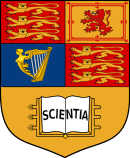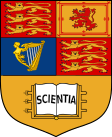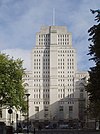|
Imperial College London
Imperial College London (Imperial) is a public research university in London, England. Its history began with Queen Victoria's husband, Prince Albert, who envisioned a cultural area in South Kensington that included museums, colleges, and the Royal Albert Hall.[6][7] In 1907, these colleges – the Royal College of Science, the Royal School of Mines, and the City and Guilds of London Institute – merged to form the Imperial College of Science and Technology.[8] In 1988, Imperial merged with St Mary's Hospital Medical School and then with Charing Cross and Westminster Medical School to form the Imperial College School of Medicine. The Imperial College Business School was established in 2003 and officially opened by Queen Elizabeth II. Formerly a constituent college of the University of London, Imperial became an independent university in 2007.[9] Imperial is organised into four faculties: Engineering, Medicine, Natural Sciences, and Business. The university fosters innovation and enterprise across all its faculties by integrating business courses into science degrees and providing business students with a scientific education.[10] The main campus is located in South Kensington, with an additional campus in White City.[11] The Faculty of Medicine also operates five teaching hospitals across London and is a founding institution of the Francis Crick Institute.[12] Its graduates and lecturers include 14 Nobel Prize winners, 3 Fields Medal winners, 74 Fellows of the Royal Society and 84 Fellows of the Royal Academy of Engineering.[13] History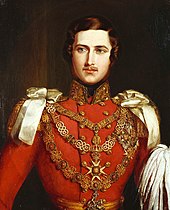 19th centuryThe earliest college that led to the formation of Imperial was the Royal College of Chemistry, founded in 1845, with the support of Prince Albert and parliament.[7] This was merged in 1853 into what became known as the Royal School of Mines.[14] The medical school has roots in many different schools across London, the oldest of which being Charing Cross Hospital Medical School which can be traced back to 1823, followed by teaching starting at Westminster Hospital in 1834, and St Mary's Hospital in 1851.[15][16][17] In 1851, the Great Exhibition was organised as an exhibition of culture and industry by Henry Cole and by Prince Albert, husband of the reigning monarch of the United Kingdom, Queen Victoria. An enormously popular and financial success, proceeds from the Great Exhibition were designated to develop an area for cultural and scientific advancement in South Kensington.[18] Within the next six years the Victoria and Albert Museum and Science Museum had opened, joined by new facilities in 1871 for the Royal College of Chemistry, and in 1881 the opening of the Royal School of Mines and Natural History Museum.[19]  In 1881, the Normal School of Science was established in South Kensington under the leadership of Thomas Huxley, taking over responsibility for the teaching of the natural sciences and agriculture from the Royal School of Mines.[20] The school was renamed the Royal College of Science by royal consent in 1890.[21] The Central Institution of the City and Guilds of London Institute was opened as a technical education school on Exhibition Road by the Prince of Wales in 1884, with courses beginning in 1885.[8]  20th centuryAt the start of the 20th century, there was a concern that Great Britain was falling behind Germany in scientific and technical education. A departmental committee was set up at the Board of Education in 1904, to look into the future of the Royal College of Science. A report released in 1906 called for the establishment of an institution unifying the Royal College of Science and the Royal School of Mines, as well as – if an agreement could be reached with the City and Guilds of London Institute – its Central Technical College.[22][23] On 8 July 1907, Edward VII granted a Royal Charter establishing the Imperial College of Science and Technology. This incorporated the Royal School of Mines and the Royal College of Science. It also made provisions for the City and Guilds College to join once conditions regarding its governance were met, as well as for Imperial to become a college of the University of London.[24] The college joined the University of London on 22 July 1908, with the City and Guilds College joining in 1910.[8][25] The main campus of Imperial College was constructed beside the buildings of the Imperial Institute, the new building for the Royal College of Science having opened across from it in 1906, and the foundation stone for the Royal School of Mines building being laid by King Edward VII in July 1909.[22] As students at Imperial had to study separately for London degrees, in January 1919, students and alumni voted for a petition to make Imperial a university with its own degree awarding powers, independent of the University of London.[26][27] In response, the University of London changed its regulations in 1925 so that the courses taught only at Imperial would be examined by the university, enabling students to gain a Bachelor of Science.[28] In October 1945, George VI and Queen Elizabeth visited Imperial to commemorate the centenary of the Royal College of Chemistry, which was the oldest of the institutions that united to form Imperial College. "Commemoration Day", named after this visit, is held every October as the university's main graduation ceremony.[29][30] The college also acquired a biology field station at Silwood Park near Ascot, Berkshire in 1947[31]  Following World War II, there was again concern that Britain was falling behind in science – this time to the United States. The Percy Report of 1945 and Barlow Committee in 1946 called for a "British MIT"-equivalent, backed by influential scientists as politicians of the time, including Lord Cherwell, Sir Lawrence Bragg and Sir Edward Appleton.[32][33] The University Grants Committee strongly opposed however,[32] and so a compromise was reached in 1953, where Imperial would remain within the university, but double in size over the next ten years.[34][35] The expansion led to a number of new buildings being erected. These included the Hill building in 1957 and the Physics building in 1960, and the completion of the East Quadrangle, built in four stages between 1959 and 1965. The building work also meant the demolition of the City and Guilds College building in 1962–63, and the Imperial Institute's building by 1967.[36] Opposition from the Royal Fine Arts Commission and others meant that Queen's Tower was retained, with work carried out between 1966 and 1968 to make it free standing.[37] New laboratories for biochemistry, established with the support of a £350,000 grant from the Wolfson Foundation, were opened by the Queen in 1965.[38][39] In 1988, Imperial merged with St Mary's Hospital Medical School under the Imperial College Act 1988. Amendments to the royal charter changed the formal name of the institution to The Imperial College of Science, Technology and Medicine and made St Mary's a constituent college.[40] This was followed by mergers with the National Heart and Lung Institute in 1995 and the Charing Cross and Westminster Medical School, Royal Postgraduate Medical School and the Institute of Obstetrics and Gynaecology in 1997, with the Imperial College Act 1997 formally establishing the Imperial College School of Medicine.[41] 21st centuryIn 2003, Imperial was granted degree-awarding powers in its own right by the Privy Council. In 2004, the Imperial College Business School and a new main college entrance on Exhibition Road were opened.[42][43] The UK Energy Research Centre was also established in 2004 and opened its headquarters at Imperial. On 9 December 2005, Imperial announced that it would commence negotiations to secede from the University of London.[44] Imperial became fully independent of the University of London in July 2007.[45][46][47] In April 2011, Imperial and King's College London joined the UK Centre for Medical Research and Innovation as partners with a commitment of £40 million each to the project. The centre was later renamed the Francis Crick Institute and opened on 9 November 2016. It is the largest single biomedical laboratory in Europe. The college began moving into the new White City campus in 2016, with the launching of the Innovation Hub.[48] This was followed by the opening of the Molecular Sciences Research Hub for the Department of Chemistry, officially opened by Mayor of London, Sadiq Khan in 2019.[49] In 2014, Stefan Grimm, of the Department of Medicine, was found dead after being told that he was "struggling to fulfil the metrics" of his professorial post.[50][51][52] The college announced an internal inquiry into his death, and found that the performance metrics for his position were unreasonable, with new metrics for performance being needed.[53] Campuses South KensingtonThe South Kensington campus is the college's main campus, where most teaching and research takes place. It is home to many notable buildings, such as the Business School, Royal School of Mines, and Royal College of Science. It is also the original site of the Imperial Institute, whose Queen's Tower stands at the heart of the campus overlooking Queen's Lawn. As part of a cultural centre known as Albertopolis the campus is surrounded by many of London's most popular attractions, including the Royal Albert Hall and Kensington Palace, museums including the Natural History Museum, Science Museum, and Victoria and Albert Museum, and institutions such as the Royal College of Art, the Royal College of Music, and the National Art Library.  The campus has many restaurants and cafés run by the college, and contains much of the college's student accommodation, including the Prince's Garden Halls, and Beit Hall, home to the college union, which runs student pubs, a nightclub, and a cinema on site. To the north, within easy walking distance of the college, are Kensington Gardens and Hyde Park, with green spaces and sports facilities used by many of the student clubs.  White City Imperial has a new second major campus in White City providing a platform for innovation and entrepreneurship. This campus was built on land previously owned by BBC.[54] The hub houses research facilities, postgraduate accommodation, as well as a commercialisation space.[55][56] The campus is home to the Scale Space and incubator, Invention Rooms, a college hackerspace and community outreach centre.[57] The White City campus also includes another biomedical centre funded by Sir Michael Uren.[58][59][60] Silwood ParkSilwood Park is a postgraduate campus of Imperial in the village of Sunninghill near Ascot in Berkshire. The Silwood Park campus remains a centre for research and teaching in ecology, evolution, and conservation. It is set in 100 hectares of parkland used for ecological field experiments. HospitalsImperial has teaching hospitals across London which are used by the School of Medicine for undergraduate clinical teaching and medical research. All are based around college-affiliated hospitals, and also provide catering and sport facilities. College libraries are located on each campus, including the Fleming library at St Mary's.[61] Organisation and administrationFaculties and departmentsImperial is organised into four faculties: the Faculty of Engineering, the Faculty of Medicine, the Faculty of Natural Sciences, and the Imperial College Business School. As of 2024,[update] the academic departments are:[62]
Imperial College Business School
Interdisciplinary centres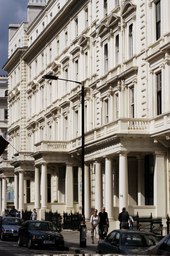 Imperial hosts centres to promote inter-disciplinary work under the titles of Global Challenge institutes, Imperial Centres of Excellence and Imperial Networks of Excellence. It also participates as a partner in a number of national institutes.[63] Global Challenge institutes:
National institutes:
Academic centresThe Centre for Languages, Culture and Communication operates as Imperial College London's adult education centre, offering evening class courses in the arts, humanities, languages and sciences.[64] The university also houses two academic centres offering teaching to undergraduate and postgraduate students in subjects outside of science, technology and medicine. The academic centres are the:
Governance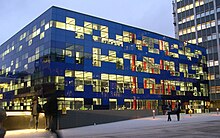 The council is the governing body of Imperial. The council consists of between 19 and 27 members, with an independent chair and ex officio members being the president, the provost, the chief operating officer, the president of Imperial College Union, and four senior staff members. There are also up to four further staff members (comprising one member elected by the academic staff, one further appointed member of academic staff and two members of the professional services staff), up to one further representative of Imperial College Union, and between nine and 13 other independent members, with the proviso that the independent members (including the chair) must comprise the majority.[65][66] The president is the highest academic official and chief executive of Imperial College London.[67] The position has been held by Hugh Brady, since August 2022[update].[68] As of 2024,[update] the provost is Ian Walmsley and the chair is Vindi Banga.[65] Finances and endowment The college's endowment is sub-divided into three distinct portfolios:
In the financial year ending 31 July 2024, Imperial had a total income of £1.309 billion (2022/23 – £1.256 million) and total expenditure of £1.051 billion (2022/23 – £1.235 billion).[2] Key sources of income included £507.5 million from tuition fees and education contracts (2022/23 – £452.1 million), £165.4 million from funding body grants (2022/23 – £183.3 million), £396.2 million from research grants and contracts (2022/23 – £383.1 million), £28.8 million from investment income (2022/23 – £24.1 million) and £35.5 million from donations and endowments (2022/23 – £51.5 million).[2] At year end, Imperial had endowments of £235.2 million (2022/23 – £220.1 million) and total net assets of £2.082 billion (2022/23 – £1.792 billion). It holds the eighth-largest endowment of any university in the UK.[2] Affiliations and partnershipsImperial is a member of the Association of Commonwealth Universities, European University Association, Global Alliance of Technological Universities, League of European Research Universities and the Russell Group. It is a founding member of the Imperial College academic health sciences centre, the Francis Crick Institute and MedCity. Imperial is a long-term partner of the Massachusetts Institute of Technology, with the first formal large-scale collaboration agreement dating back to 1944 as part of World War II scientific effort.[70] The partnership between the two institutions continues with exchange programs for students and academic staff.[71][72] Academic profileResearchIn the 2021 Research Excellence Framework, Imperial's research profile was assessed as 66 per cent world class (4*) 30 per cent internationally important (3*) and 3 per cent internationally recognised (2*), with insignificant quantities of research in lower categories. This led to Imperial being ranked first in the UK on GPA and ninth for research power by Times Higher Education, with a GPA of 3.63 and research power 47.3 per cent of the top-ranked University of Oxford.[73] The college promotes research commercialisation, partly through its dedicated technology transfer company, Imperial Innovations, which has given rise to a large number of spin-out companies based on academic research.[74][75] Imperial researcher Narinder Singh Kapany made critical contributions to the invention of fibre optics.[76][77] 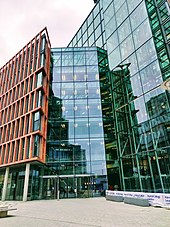 The United States is the college's top foreign country for collaborations,[78] and Imperial College has a long-term partnership with the Massachusetts Institute of Technology that dates from World War II.[70] In January 2018, the mathematics department of Imperial and the French National Centre for Scientific Research launched an "international joint research unit" (unité mixte internationale; UMI) at Imperial, known as UMI Abraham de Moivre after the French mathematician, focused on unsolved problems and bridging British and French scientific communities.[79] In October 2018, Imperial College launched the Imperial Cancer Research UK Center, a research collaboration that aims to find innovative ways to improve the precision of cancer treatments, inaugurated by Joe Biden as part of his Biden Cancer Initiative.[80][81] Neil Ferguson's 16 March 2020 report entitled "Impact of non-pharmaceutical interventions to reduce COVID-19 mortality and healthcare demand" was described in a New York Times article as the coronavirus "report that jarred the U.S. and the U.K. to action".[82][83] Since 18 May, Imperial College's Dr. Samir Bhatt advised the state of New York for its reopening plan.[84] The governor of New York, Andrew Cuomo, said at the time that "the Imperial College model, as we've been following this for weeks, was the best, most accurate model."[84] Admissions
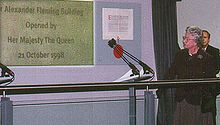 In the academic year 2021/22, the ratio of applicants to admissions was 9:1 for undergraduates and 7.7:1 for postgraduates.[92] The university gave offers of admission to 30.1% of its undergraduate applicants in 2022, the 7th lowest offer rate across the country.[93] The undergraduate courses with the highest ratios of applicants to admissions were computing (19.2:1), mathematics (14.6:1) and mechanical engineering (11.2:1).[92] The postgraduate courses with the highest ratios of applicants to admissions were computing (21:1), mathematics (17.9:1), and electrical engineering (14:1).[92] Imperial is among the most international universities in the United Kingdom,[94][95] with 50% of students from the UK, 16% of students from the EU, and 34% of students from outside the UK or EU.[94][96][97] The student body is 39% female and 61% male.[97] 36.5% of Imperial's undergraduates are privately educated, the fourth highest proportion amongst mainstream British universities.[95] LibrariesThe college's main library is located next to Queen's Lawn and contains the main corpus of the college's collection. It previously also housed the Science Museum's library until 2014.[98] The Fleming library is located at St Mary's in Paddington, originally the library of St Mary's Hospital Medical School, with other hospital campuses also having college libraries.[99] MedicineThe Imperial Faculty of Medicine was formed through mergers between Imperial and the St Mary's, Charing Cross and Westminster, and Royal Postgraduate medical schools and has six teaching hospitals. It accepts more than 300 undergraduate medical students per year and has around 321 taught and 700 research full-time equivalent postgraduate students. 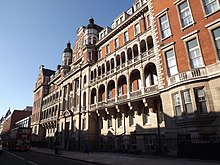 Imperial College Healthcare NHS Trust was formed on 1 October 2007 by the merger of Hammersmith Hospitals NHS Trust (Charing Cross Hospital, Hammersmith Hospital and Queen Charlotte's and Chelsea Hospital) and St Mary's NHS Trust (St. Mary's Hospital and Western Eye Hospital) with Imperial College London Faculty of Medicine.[100] It is an academic health science centre and manages five hospitals: Charing Cross Hospital, Queen Charlotte's and Chelsea Hospital, Hammersmith Hospital, St Mary's Hospital, and Western Eye Hospital. The Trust is currently one of the largest in the UK and in 2012/13 had a turnover of £971.3 million, employed approximately 9,770 people and treated almost 1.2 million patients.[101]  Other (non-academic health science centres) hospitals affiliated with Imperial College include Chelsea and Westminster Hospital, Royal Brompton Hospital, West Middlesex University Hospital, Hillingdon Hospital, Mount Vernon Hospital, Harefield Hospital, Ealing Hospital, Central Middlesex Hospital, Northwick Park Hospital, St Mark's Hospital, St Charles' Hospital and St Peter's Hospital.[102] Reputation and rankings
National league tables over ten years Global league tables over the years 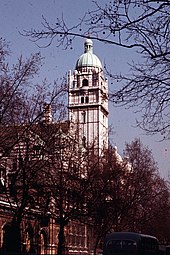 Imperial is widely recognised as one of the UK's elite universities.[109][110][111] In 2025, the QS World University Rankings ranked Imperial second in the world, behind MIT, equalling its highest ever position. Similarly, the Times Higher Education World University Rankings ranked it ninth in the world. Imperial has cultivated an entrepreneurial culture by integrating business and finance disciplines across its science-focused curriculum. This approach is supported by the UK's largest mentoring system, inspired by MIT's model. The university's Enterprise Lab has a high 79 per cent survival rate for startups.[112] Reflecting this, the 2023 QS MBA Rankings by Career Specialisation in Entrepreneurship placed Imperial's MBA programme third in the world,[113] while the 2018 Reuters World's Most Innovative Universities ranking placed Imperial eighth in the world. [114] Imperial's focus on entrepreneurship and industry placements, along with the subject mix taught, has led to high employability of its graduates. In 2024, Imperial was ranked first in the UK for highly skilled employment or further studies by the Complete University Guide,[115] the Guardian University Guide,[116] and the Times Good University Guide.[117] An analysis of Higher Education Statistics Agency salary data for 2021 found that Imperial graduates had the highest median salaries across all subjects of any UK university.[118] Student lifeStudent bodyFor the 2022/23 academic year, Imperial had a total full-time student body of 19,400, consisting of 10,475 undergraduate students and 8,925 postgraduates.[119] 50.7% of the student body is from outside of the UK.[120] 32% of all full-time students came from outside the European Union in 2013–14,[121] and around 13% of the International students had Chinese nationality in 2007–08.[122] Imperial's male to female ratio for undergraduate students is uneven at approximately 64:36 overall,[122] and 5:1 or higher in some engineering courses. However, medicine has an approximate 1:1 ratio with biology degrees tending to be higher.[123] Imperial College UnionImperial College Union is the students' union and is run by five full-time sabbatical officers elected from the student body for a tenure of one year, and a number of permanent members of staff. It is split into constituent unions aligned with the faculties of the college, carrying on the association with the original constituent colleges of Imperial, the Royal College of Science Union, City and Guilds College Union, Royal School of Mines Students' Union and Imperial College School of Medicine Students' Union. The Union is given a large subvention by the university, much of which is spent on maintaining over 300 clubs, projects and societies.[124] Examples of notable student groups and projects are Project Nepal which sends Imperial College students to work on educational development programmes in rural Nepal[125] and the El Salvador Project, a construction based project in Central America.[126] The Union also hosts sports-related clubs such as Imperial College Boat Club and Imperial College Gliding Club. The Union operates on two sites, with most events at the Union Building on Beit Quad at South Kensington, with mostly medical school events at the Reynold's bar, Charing Cross. Facilities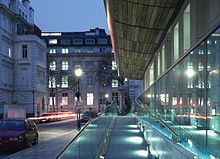 Sports facilities at Imperial's London campuses include four gyms, including the main Ethos gym at the South Kensington Campus, two swimming pools and two sports halls.[127] Imperial has additional sports facilities at the Heston and Harlington sports grounds. On the South Kensington campus, there are a total of six music practice rooms which consist of upright pianos for usage by people of any grade, and grand pianos which are exclusively for people who have achieved Grade 8 or above.[128] There are two student bars on the South Kensington campus, one at the Imperial College Union and one at Eastside.[129] There are a number of pubs and bars on campus and also surrounding the campus, which become a popular social activity for Imperial's students. The Pewter tankard collection at Imperial College Union is the largest in Europe, with the majority of clubs and societies having tankards associated with their clubs.[130] 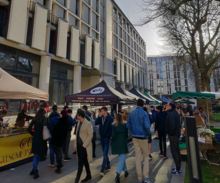 Student mediaImperial College RadioImperial College Radio (ICRadio) was founded in November 1975 with the intention of broadcasting to the student halls of residence from a studio under Southside, actually commencing broadcasts in late 1976. It now broadcasts from the West Basement of Beit Quad over the internet.[131] Imperial College TVImperial College Television (ICTV) is the university's TV station, founded in 1969 as STOIC (Student Television of Imperial College) and operated from a small TV studio in the Electrical Engineering block. The department had bought an early AMPEX Type A 1-inch videotape recorder and this was used to produce an occasional short news programme which was then played to students by simply moving the VTR and a monitor into a common room. A cable link to the Southside halls of residence was laid in a tunnel under Exhibition Road in 1972. Felix NewspaperFelix is weekly student newspaper, first released on 9 December 1949.[132] In addition to news, Felix also carries comic strips, features, opinions, puzzles and reviews, plus reports of trips and Imperial College sporting events.  Student societiesImperial College Boat ClubThe Imperial College Boat Club is the rowing club of Imperial and was founded on 12 December 1919. The college's boat house is located in Putney on the Thames, and has been refurbished, reopening in 2014.[133] SportsImperial College has over 60 sports clubs,[134] of which many participate in the British Universities and Colleges Sport Association leagues such as American Football, Rugby, Badminton, Lacrosse, Football, Ice Hockey, and many others.[134] Exploration Club  Imperial's Exploration Board was established in 1957 to assist students with a desire for exploration. Trips have included Afghanistan, Alaska, Cameroon, Ethiopia, Fiji, the Himalayas, Iran, Morocco, Norway, Tanzania, Thailand, Ukraine, and the Yukon.[135] Dramatic SocietyThe Imperial College Dramatic Society (DramSoc)[136] is one of two major theatrical arts societies, with the other being the Musical Theatre Society, and it was founded in 1912.[137] The society puts on three major plays each year, in addition to several smaller fringe productions. It is additionally one of the London-based dramatic societies to participate in the London Student Drama Festival,[138] and regularly attends the Edinburgh Fringe. DramSoc is responsible for the day-to-day maintenance of the Union's theatrical space, the Union Concert Hall. The TechtonicsThe Techtonics are an all-male a cappella group from Imperial College London, and are a part of the Imperial College A Cappella Society.[139] The group was formed in 2008, and has since risen to prominence in the world a cappella scene. The group is best known for winning the International Championship of Collegiate A Cappella in 2016.[140] Student housingImperial College owns and manages ten halls of residence in Inner London, Acton and Ascot, Berkshire. Over three thousand rooms are available, with first year undergraduates guaranteed a place in one of the six main college residences (subject to certain requirements). The majority of halls offer single or twin accommodation with some rooms having en suite facilities. Bedrooms are provided with basic furniture and with access to shared kitchens and bathrooms. All rooms come with internet access and access to the Imperial network.[141] Most students in college or university accommodation are first-year undergraduates. The majority of older students and postgraduates find accommodation in the private sector, help for which is provided by the college private housing office. However a handful of students may continue to live in halls in later years if they take the position of a "hall senior", and places are available for a small number of returning students in three small halls.[142] The accommodation in Ascot is only for postgraduate students based at the Silwood Park site.[143] Notable alumni, academics and other staff
Nobel laureates have included: Sir Ernst Boris Chain (medicine); Abdus Salam, Sir George Paget Thomson, Lord Patrick Blackett and Dennis Gabor (physics); and Sir Norman Haworth, Sir Cyril Norman Hinshelwood, Sir Derek Barton and Sir Geoffrey Wilkinson (chemistry).[144] Fields medalists have included Klaus Friedrich Roth, Sir Simon Donaldson and Martin Hairer.[145] Academics: Sir Tom Kibble, co-discoverer of the Higgs Boson; Dame Sally Davies, the Chief Medical Officer for England; Sir Edward Frankland, originator of the theory of chemical valency; Sir William Crookes, discoverer of the thallium;[146] Thomas Huxley, advocate of the theory of evolution; George E. Davis, founding father of chemical engineering; Sir Alec Skempton, one of the founding fathers of soil mechanics;[147] Sir John Ambrose Fleming, inventor of the vacuum tube; Narinder Singh Kapany, inventor of fibre optics; Sir Steven Cowley, president of Corpus Christi College, Oxford;[148] Julia King, Baroness Brown of Cambridge, Member of the House of Lords;[149] Dame Judith Hackitt, Chair of the Health and Safety Executive; and Huw Thomas, Physician to the Queen.[150] Other alumni have included: Adventure and Exploration: Sir Roger Bannister, ran the first four-minute mile;[151] Andreas Mogensen, first Danish astronaut; David Warren, inventor of the flight data recorder and cockpit voice recorder;[152] Nikolas Tombazis, chief car designer at McLaren and Ferrari;[153] and Nicola Fox, Head of Science at NASA.[154] Politics: Sir Julius Vogel, former Prime Minister of New Zealand;[155] Rajiv Gandhi, former Prime Minister of India;[156] Teo Chee Hean, Senior Minister of Singapore (formerly Deputy Prime Minister of Singapore); Edem Tengue, Minister of maritime economy of the republic of Togo; Henry Charles Stephens, politician; Chen Jining, Mayor of Beijing, Secretary of Shanghai;[157] Dyah Roro Esti Widya Putri, member of House of Representatives of the Republic of Indonesia; Business: Ralph Robins, CEO of Rolls-Royce; Chew Choon Seng, CEO of Singapore Airlines; Cyrus Pallonji Mistry, chairman of the Tata Group;[158] Ian Read, CEO of Pfizer; Iain Conn, Managing Director of BP; Danny Lui, co-founder of Lenovo; Michael Cowpland, founder of Corel;[159] Alan Howard, co-founder of Brevan Howard and philanthropist; Michael Birch, entrepreneur; Andrew Rickman, UK's first tech billionaire;[160] and Sir Michael Uren, businessman and philanthropist. Literature and Music: H. G. Wells, author; Simon Singh, author; Brian May, guitarist of rock band Queen; Pallab Ghosh, BBC correspondent; and Hannah Devlin, science journalist. See alsoExplanatory notes
References
External links
|
||||||||||||||||||||||||||||||||||||||||||||||||||||||||||||||||||||||||||||||||||||||||||||||||||||||||||||||||||||||||||||||||||||||||||||||||||
